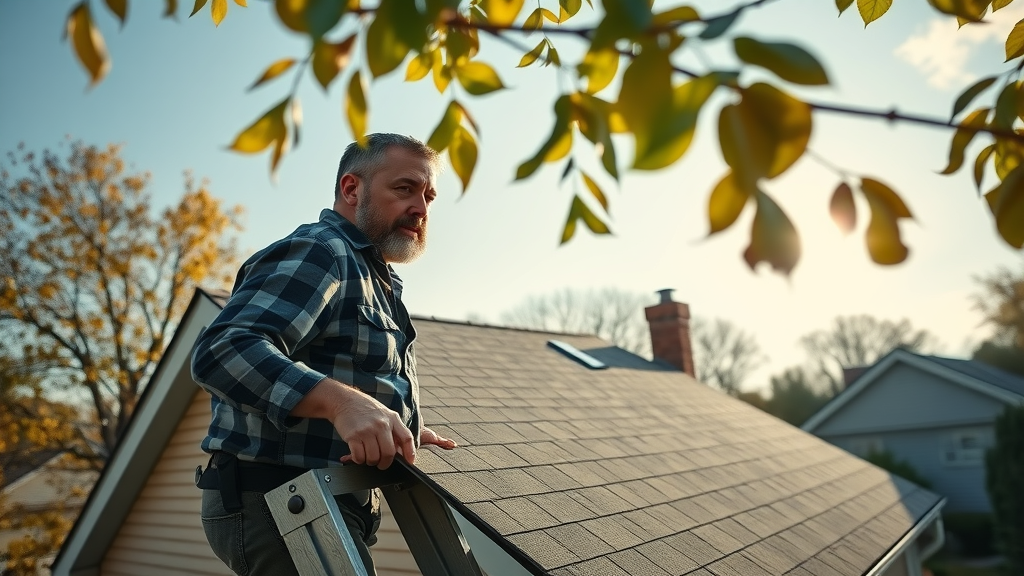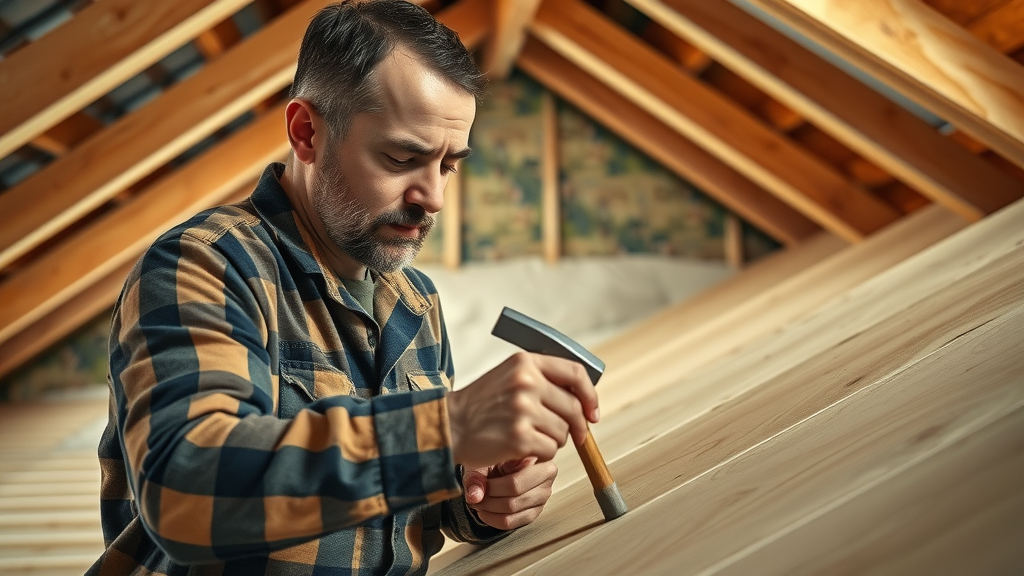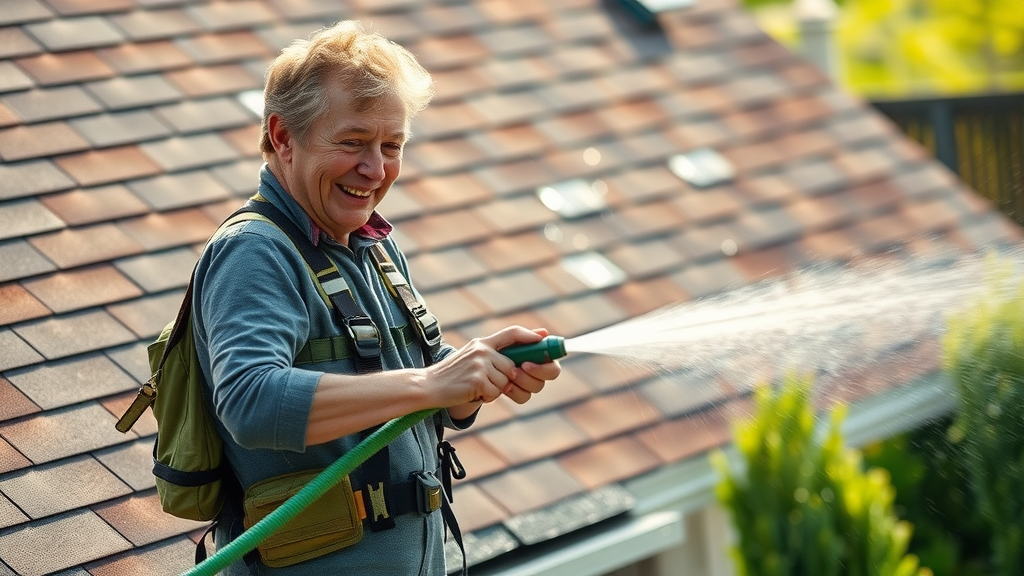What if you could double the life of your roof simply by dedicating a few hours each season? With DIY roof maintenance , you have the power to protect your home and avoid the jaw-dropping repair bills that leave so many homeowners reeling. In this guide, you’ll learn the easy-to-implement strategies trusted by roofing pros to extend the life of your roof, spot potential problems before they balloon, and know when to call a pro—so you can keep your biggest investment safe and dry, year after year.
Startling Facts: Why DIY Roof Maintenance Matters More Than Ever
Many homeowners underestimate the importance of regular roof maintenance —but did you know that a neglected roof can lose up to half its lifespan ? This means your 25-year roof might need replacement in just 12 years, leading to expensive roof repairs or even early roof replacement . Given that a major roof project can easily exceed tens of thousands of dollars, adopting a proactive approach with diy roof maintenance isn’t just wise—it protects your investment and your entire home.
"A neglected roof can shorten the life of your roof by up to 50%, costing homeowners thousands in emergency roof repairs."
From missing shingles after high winds to clogged gutters causing water damage , small oversights add up fast. Left unchecked, simple problems quickly evolve into structural damage or dangerous leaks. That’s why a solid strategy for maintaining your roof saves time, money, and stress—making it a must for every responsible homeowner.

Maximize the Life of Your Roof: Key DIY Roof Maintenance Tips
Proper roof maintenance is the secret to getting the most out of your shingles, tiles, or metal covering. The good news: you don’t need to be a roofing pro to make a difference. Familiarity with the basic principles of diy roof maintenance gives you tremendous leverage against the natural wear and tear every roof faces. With regular attention and the right maintenance tips , it’s possible to prevent water damage, stave off expensive roof repairs , and extend the life of your roof for years past its expected lifespan.
This section covers some of the most impactful roof maintenance tips every homeowner should know. By creating a habit of periodic inspections and minor fixes, you not only save money but also maintain the aesthetic and structural integrity of your home. Let’s look at the go-to actions recommended by both DIY enthusiasts and professional roofers alike.
- Remove debris regularly: Leaves, sticks, and trash collect on roofs and in gutters, trapping moisture and accelerating rot.
- Check for missing shingles after storms or high winds: Early replacement prevents water damage and costly interior repairs.
- Clean your gutters every season: Clogged gutters can cause water to back up, leak under the roof deck, and cause significant structural problems.
- Inspect flashing and seals: These are common leak points. Cracks, rust, or gaps should be addressed immediately to avoid larger roof repairs .
- Trim overhanging branches: Falling limbs and friction from swaying leaves can damage roofing material and break seals on valleys or hips.
Roof Maintenance Checklist: Your Step-by-Step DIY Roof Maintenance Guide
A systematic approach is key to effective diy roof maintenance . A well-organized roof maintenance checklist keeps you on track and ensures that nothing slips through the cracks. Inspections and preventive tasks should be performed throughout the year, but especially after severe weather. Refer to this checklist for practical steps that address the most common roof maintenance needs—helping you protect your home and avoid costly surprises.
| Task | Frequency | Tools Needed | Warning Signs |
|---|---|---|---|
| Remove debris (leaves, branches) | Monthly / After storms | Roof rake, gloves | Piles of debris, moss growth |
| Inspect and clean gutters | Every season | Ladder, bucket, gloves | Overflowing water, clogged spouts |
| Check for missing or damaged shingles | Quarterly | Binoculars, replacement shingles | Curling, cracks, gaps |
| Examine flashing & seals | Bi-annually | Caulking gun, sealant, putty knife | Rust, visible gaps, leaks |
| Trim overhanging branches | As needed (annually or after storms) | Pruning shears, saw | Broken limbs near roof, debris buildup |
| Inspect attic for water stains or leaks | Bi-annually / During heavy rain | Flashlight | Dark spots, damp insulation, musty smell |

Understanding Common Roof Repairs to Prevent Costly Roof Damage
Even the best-maintained roofs encounter occasional issues—prompt identification and swift roof repairs can prevent small annoyances from becoming extensive water damage or structural damage . The awareness that comes from vigilant roof maintenance allows you to spot and solve problems before they spread. Not all repairs require expert skills, but knowing when to call a pro can save your roof (and wallet) from disaster.
The main areas of concern involve leaks, damages to the roof deck , and failing shingles. In this section, we’ll explore how DIY homeowners can play a pivotal role in minimizing disruption, extending the life of your roof , and maintaining the value of your home.
Detect Leaks and Water Stains Early with Proper Roof Maintenance
Water infiltration is among the most common triggers for expensive roof repairs . A critical maintenance tip is to periodically check for water stains on ceilings and in the attic. These stains, especially after heavy rain, typically point to a compromised zone—such as missing shingles, cracked flashing, or compromised seals around roof penetrations. If left unchecked, leaks can lead to extensive water damage within your walls, insulation, and framing, sometimes going unnoticed until mold and rot have set in.
An effective way to prevent water damage is to perform detailed inspections with a flashlight during or immediately after storms. Moisture in unexpected places usually indicates a vulnerability in your roof maintenance plan. Addressing minor leaks promptly with roofing cement and patches is a basic diy roof skill that pays dividends by stopping secondary problems before they start.
Evaluating the Condition of Your Roof Deck for DIY Roof Maintenance
The roof deck is the unsung hero beneath your shingles—a solid foundation that supports all layers of roofing material. Over time, moisture from leaks can weaken this critical platform, making the entire system vulnerable to structural damage . A comprehensive roof maintenance checklist always includes a close examination of the attic, hunting for soft spots, sagging, or visible staining. Use a small hammer to tap the wood and listen for dull thuds (a sign of hidden rot).
Identifying rot or water damage early positions you to make minor repairs yourself—replacing a small section of plywood, for example, is much less costly than a full roof replacement . However, if the compromised area is large or affects structural beams, call a pro to ensure the safety and strength of your home are maintained.

DIY Solutions for Minor Roof Repairs and When to Call a Pro
Minor problems like replacing a missing shingle or resealing flashing are well within the scope of a diy roof enthusiast—provided proper safety is observed, including a safety harness and sturdy ladder. Homeowners can use roofing cement, caulk, and spare shingles to patch small sections, preventing water damage and saving money on immediate roof repairs .
But it’s essential to recognize your limits. If the damage includes more than one layer of shingles, widespread leaks, or visible roof deck deterioration, it’s time to call a pro . Engaging a reputable roofing company ensures your repairs are durable and safe, especially when warranties or insurance claims are involved.
Maintaining Your Roof Through the Seasons: Seasonal Maintenance Tips
Nature is an ever-changing force—each season brings unique stress to your home’s roofing system. Adapting your diy roof maintenance routine can help you prepare for seasonal threats and prevent wear. Whether it’s spring’s heavy rains, fall’s decaying leaves, or summer’s intense sun, tailored maintenance tips for each period are your best defense against cumulative damage and premature roof repairs .
- Spring: Clear away all winter debris, inspect for granule loss on shingles, and scan for mold or lingering moisture under eaves.
- Fall: Carefully remove fallen leaves and branches, tighten up loose gutters, and proactively check attic insulation before winter.
- Summer: Look for softened or warped materials due to sun exposure; repair them before thunderstorms roll in.
- Winter (as needed): Safely remove ice dams using specially-designed rakes from the ground, and ensure attic ventilation to keep the roof deck dry.

Avoid Structural Damage: Inspecting and Reinforcing Your Roof
Structural damage is one of the most serious forms of roof failure. From sagging ridge lines to interior wall cracks, the warning signs of underlying problems with the roof deck or framing must not be ignored. Regular roof inspections —including inside the attic and along the roofline—help in identifying early issues before they threaten your home’s safety or require a full roof replacement .
Many homeowners don’t realize that a sagging roof deck or persistent leaks can indicate deeper settling issues. If you notice any of these signs, it’s time to prioritize an in-depth inspection. When in doubt, a professional roof evaluation is the safest way to avoid catastrophic structural damage and protect your investment.
Recognizing Signs of Structural Damage in Roof Maintenance
Detecting structural damage requires a critical eye and a methodical approach. Signs worth investigating include uneven roof lines, visible bowing of the deck, unexplained interior ceiling cracks, or doors and windows that suddenly become difficult to open. These problems signal that your roof deck and its supports may be at the end of its life or have been compromised by years of neglected roof maintenance .
If these issues appear, temporary fixes won’t suffice. A thorough investigation—by a handyman or roofing contractor —will confirm if structural beams or trusses need reinforcing or replacing. Remember: ignoring these symptoms often leads to extensive roof repairs and even threatens the integrity of your entire home.
How Professional Roof Inspections Complement Your DIY Roof Maintenance
No matter how thorough your diy roof maintenance routine is, certain risks and potential problems are best assessed by a professional roof inspector . A trained eye can identify subtle issues—such as improper underlayment, hidden water channels, or incorrect flashing installation—that elude even the most diligent homeowners.
It’s wise to schedule a roof inspection every few years, or annually if your home is older or has recently faced severe weather. Proactive collaboration between DIY checks and professional scrutiny is an unbeatable strategy to extend the life of your roof and avoid unforeseen roof repairs .
DIY Roof Cleaning: Safe and Effective Methods
Cleaning your roof is a vital aspect of roof maintenance that ensures long-term performance and keeps damages at bay. Moss, algae, and built-up grime can trap moisture and cause shingles to decay faster. To clean safely, always use a safety harness and soft, roof-friendly brushes. Avoid pressure washers, which can strip away protective coatings and lead to premature roof replacement .
A gentle rinse using a garden hose, paired with a soft brushing motion, is effective for most types of roof materials. When working with steep slopes or particularly grimy patches, prioritize proper safety at all times—never work in wet or windy conditions, and always have a spotter on the ground when working on a ladder or roof.

Watch our expert-led tutorial for roof cleaning techniques, the right tools, and essential safety reminders to protect your shingles and your safety.
When to Call a Pro: Recognizing Limitations in DIY Roof Maintenance
While diy roof maintenance is effective for minor issues, knowing your limits is essential to avoid injury and prevent further damage. Complicated repairs involving extensive shingle loss, major water damage , or visible structural damage call for a professional assessment. Attempting complex fixes without the right skills can void warranties or even put your safety at risk.
"Some maintenance tips are best left to the roofing pros—know when to schedule a professional inspection."
If you ever feel unsure, or if a roof inspection uncovers daunting tasks, don’t hesitate to call a pro . Professional roofers and inspectors rely on specialized equipment and years of expertise to bring lasting solutions and peace of mind. Partnering with a reputable roofing company ensures your roof continues to protect your home as designed.
Frequently Asked Questions About DIY Roof Maintenance
What maintenance does a roof need?
Roof maintenance includes clearing debris, inspecting and repairing shingles, cleaning gutters, checking attic spaces for leaks or stains, and assessing flashings and seals around vents and chimneys. Task frequency may differ depending on roof type, age, and local climate. This proactive approach prevents minor roof repairs from turning into structural issues or full roof replacements.
Can I do roof repair myself?
Many minor roof repairs—such as patching small leaks, replacing missing shingles, or resealing flashing—can be handled with basic DIY skills and proper safety measures. However, for more complicated repairs, significant water damage, or structural concerns, it's always best to call a pro for a thorough roof inspection and safe, lasting fixes.
How do I clean my roof myself?
To clean your roof safely, start by removing debris with a roof rake or broom, then rinse gently with a garden hose. Never use a pressure washer, as it can damage most types of roof materials. For stubborn stains, use a roof-approved soft brush and always wear a harness if working on steep slopes or high rooftops.
Is $30,000 too much for a roof?
The cost of a new roof depends on materials, roof size, local labor rates, and extent of underlayment or repair work required. For larger homes or high-end roofing material, costs can approach or surpass $30,000. However, average residential roofs typically fall well under that price, so if a quote seems high, always obtain multiple estimates from reputable roofing contractors.
Top Five DIY Roof Maintenance Mistakes and How to Avoid Them
Even well-intentioned DIYers can make missteps that inadvertently shorten the life of your roof . Here are five common mistakes—and the maintenance tips to avoid them:
- Ignoring safety: Skipping safety harnesses or proper ladder setup can result in injuries. Proper safety is non-negotiable on every project.
- Overlooking minor issues: A single missing shingle or clogged gutter isn’t harmless. Always address any damage immediately.
- Using improper cleaning tools: Power washers and stiff wire brushes cause more harm than good. Use roof-friendly, soft-bristled tools.
- Incomplete inspections: Failing to check attic spaces or the underside of the roof deck can allow water damage to go undetected.
- Delaying professional help: Don’t wait until the last minute to call a pro . Large or persistent issues need a roofing pro for safe, effective resolution.
Understand the most frequent homeowner mistakes and see how to correct them with real-world examples and safety protocols from a roofing pro.

Expert Roof Maintenance Tip: Extending the Life of Your Roof
"Consistent, thorough roof maintenance is the single most effective maintenance tip for avoiding expensive roof repairs in the future." – Roofing Professional
There’s simply no substitute for routine attention. Develop a habit of seasonal checks, targeted cleaning, and fast, effective repairs, and you’ll enjoy a longer-lasting, better performing roof—without surprise expenses or extensive repairs.
People Also Ask
What maintenance does a roof need?
Every roof needs debris removed, routine gutter cleaning, prompt shingle and flashing repair, checks for attic leaks, and seasonal inspections from both inside and out. This keeping up with the basics is your best defense against premature roof failure and expensive repairs.
Can I do roof repair myself?
Yes, for many basic jobs, like patching small leaks and replacing shingles, DIY is both sensible and cost-effective. Always use a safety harness, and if the problem appears complex—especially involving the roof deck or framing—don’t hesitate to call a pro.
How do I clean my roof myself?
Remove branches and leaves, then use a garden hose and a soft, non-metallic brush for spot cleaning. Avoid using high-pressure tools, and always maintain three points of contact on the ladder or roof for optimal safety.
Is $30,000 too much for a roof?
For a standard residential roof, $30,000 is typically on the higher end. This price may reflect large, intricate, or premium-material jobs. Always request detailed, itemized estimates from at least two or three roofing companies before committing.
Summary and Call for Professional Help When Needed
Start a regular diy roof maintenance routine today, and you’ll avoid unnecessary roof repairs and dramatically extend the life of your roof. If something looks beyond your scope, call today for more information (214) 500-8787 and let a professional roofer keep your home protected.
Maintaining your roof is crucial to extending its lifespan and preventing costly repairs. For a comprehensive understanding of what tasks you can safely handle and which ones require professional assistance, consider reading DIY Roof Maintenance: What You Can and Shouldn’t Do . This resource outlines essential maintenance activities suitable for homeowners and highlights situations where expert intervention is advisable.
Additionally, the article 9 Easy DIY Maintenance Tips To Extend Your Roof’s Life offers practical advice on routine inspections, cleaning gutters, and trimming overhanging branches to keep your roof in optimal condition.
By incorporating these strategies into your regular home maintenance routine, you can effectively safeguard your roof against common issues and ensure its durability for years to come.
 Add Row
Add Row  Add
Add 




Write A Comment